Art Deco architecture is a celebration of timeless elegance, blending bold geometric forms with luxurious details to create exteriors that exude sophistication. From the sleek horizontal lines to the intricate decorative moldings, this design style has remained a symbol of modernity and glamour since its inception in the 1920s. Whether you're renovating a historic home or incorporating Art Deco elements into a contemporary build, the possibilities are endless when it comes to crafting a facade that stands out. In this exploration of 15 Art Deco house exterior ideas, we’ll uncover how to infuse your home with the charm and grandeur of this iconic style. Ready to transform your exterior into a masterpiece of timeless elegance? Let’s dive in.
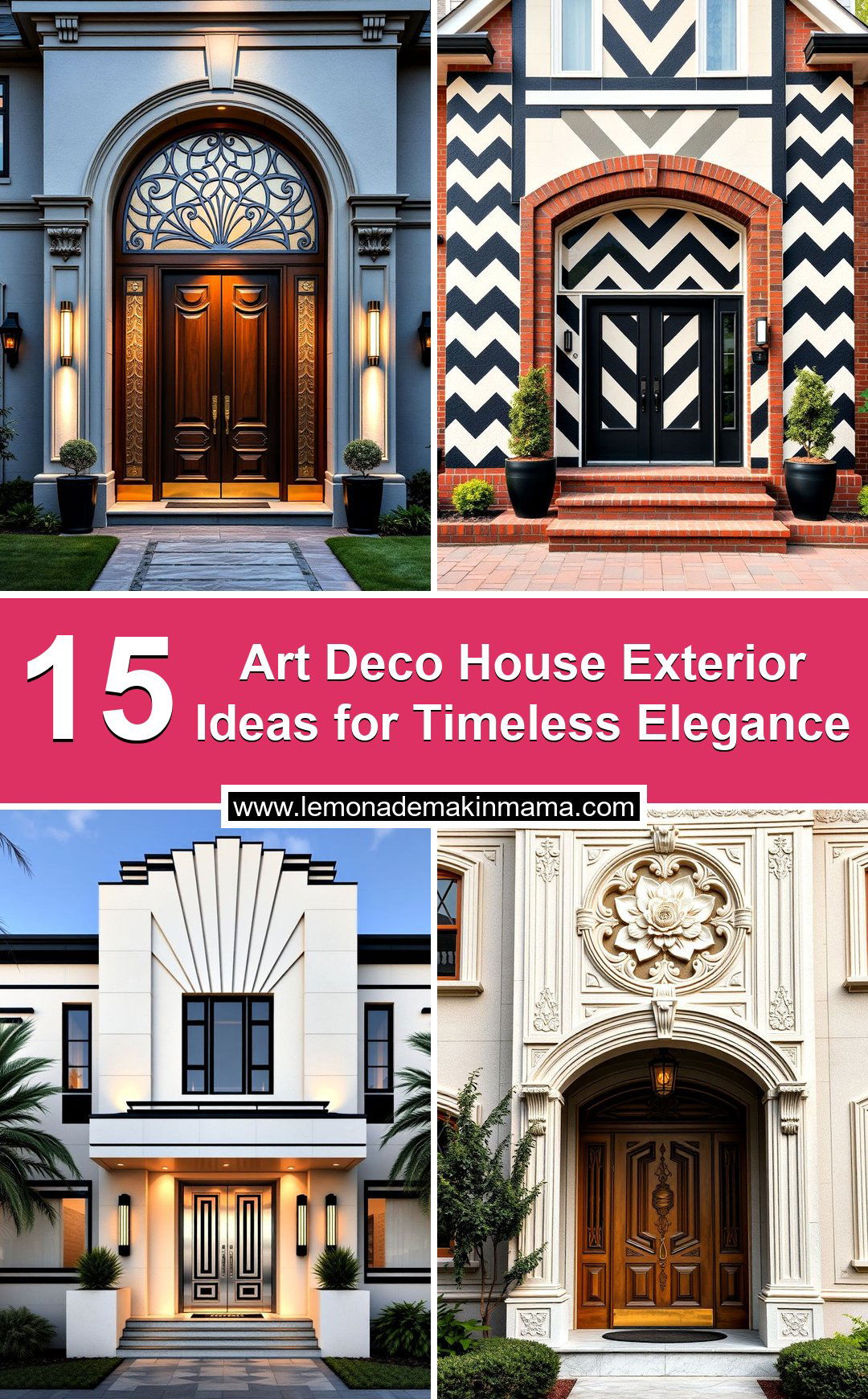
1. **Geometric Facades with Bold Lines**

Embrace the essence of Art Deco with a facade defined by sharp, geometric patterns and bold linear symmetry. These features evoke a sense of structured elegance, often complemented by stucco or concrete finishes. Adding layered reliefs or horizontal banding enhances the design’s depth. Use contrasting colors like black, white, or metallic accents to highlight the geometry, making the house a striking visual statement. This style perfectly balances classic grandeur with modern sophistication.
2. **Curved Corners and Rounded Edges**
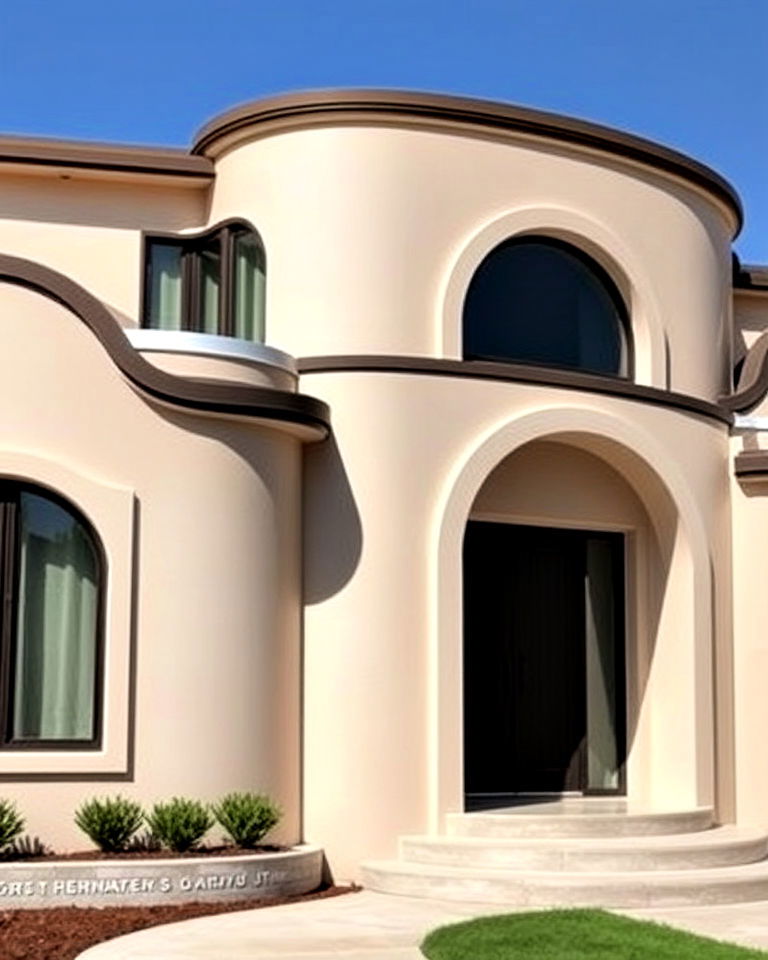
Rounded corners and smooth, curvilinear edges create a soft yet dynamic aesthetic for Art Deco homes. This design element breaks away from rigid forms, giving the exterior a streamlined and aerodynamic appearance. Pair these shapes with glass block windows or sleek horizontal trim for a cohesive look. The smooth curves evoke a sense of movement and flow, aligning with the era’s fascination with futuristic design.
3. **Metallic Accents and Details**
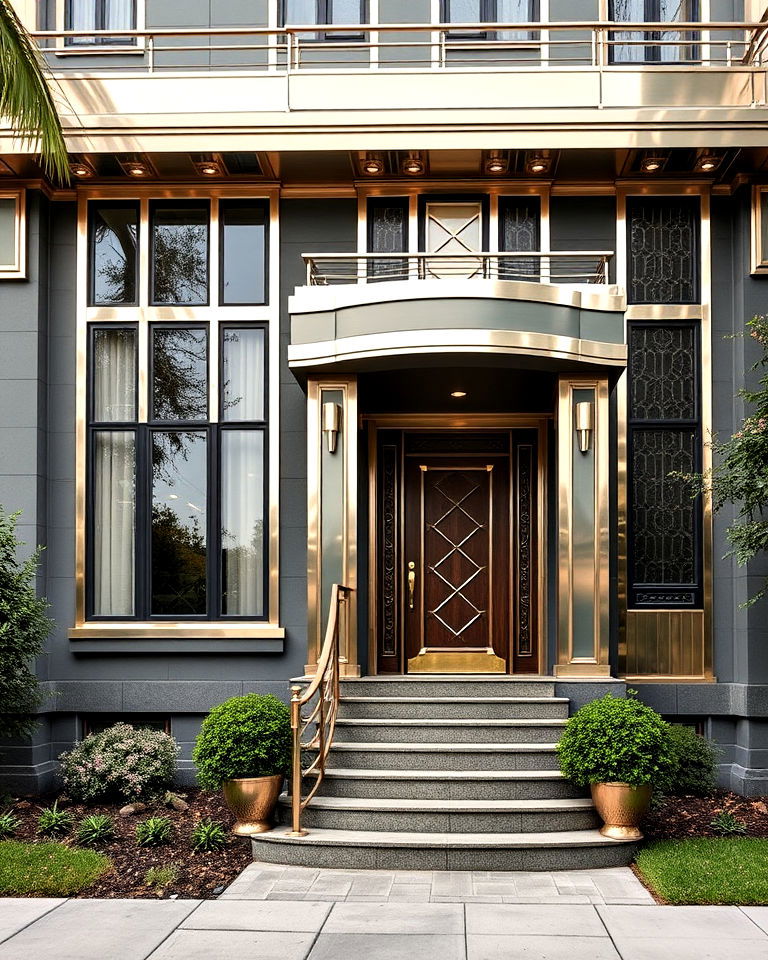
Incorporate metallic finishes like chrome, brass, or brushed steel to infuse the exterior with a touch of luxury. These elements can appear as trim on windows, doors, or rooflines, or as decorative panels and railings. The reflective quality of metals adds a glamorous sheen, which contrasts beautifully with muted facade colors. Metallic details are a hallmark of Art Deco, exuding timeless opulence.
4. **Decorative Moldings and Reliefs**

Add character to your exterior with intricate moldings and bas-reliefs that showcase floral or abstract motifs. These decorative features can adorn doorways, windows, or even entire wall panels, emphasizing the artistic side of the Art Deco movement. Opt for symmetrical placement and geometric designs to maintain a cohesive and balanced look. These details make the house feel like a piece of living art.
5. **Streamlined Horizontal Banding**

Horizontal banding adds rhythm and visual balance to Art Deco facades. Use layered stucco or contrasting materials to create stripes that wrap around the building. This design technique elongates the house visually, emphasizing a sleek and modern silhouette. Combined with neutral tones, the banding can serve as both a decorative and structural element, embodying the style's streamlined elegance.
6. **Symmetrical Design and Strong Axial Layouts**
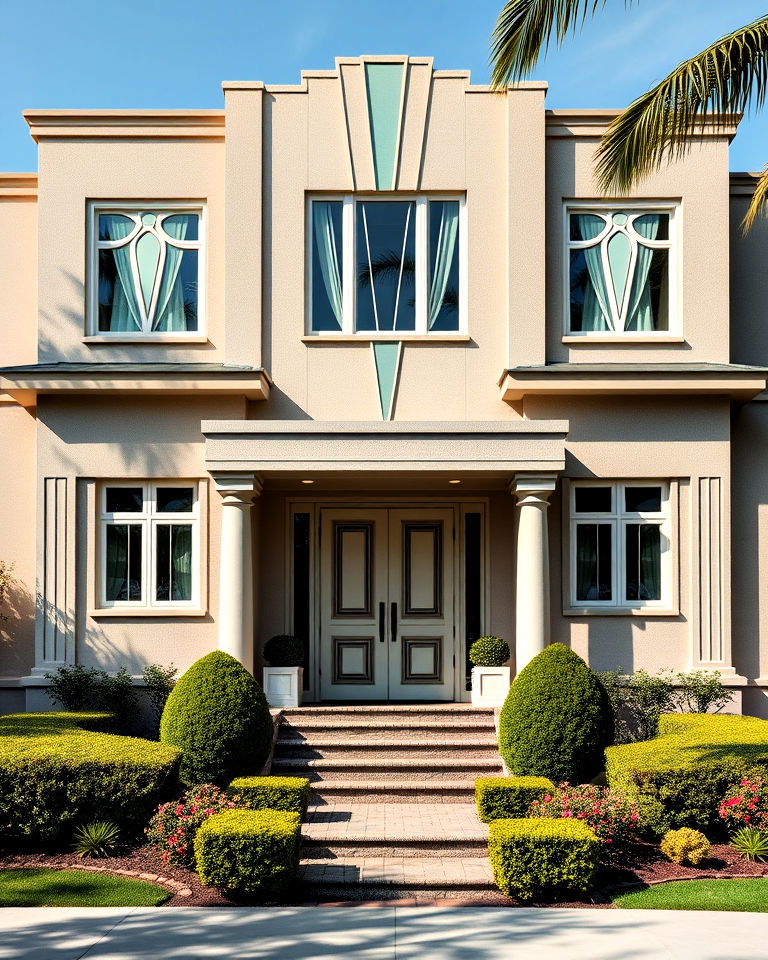
Art Deco exteriors often emphasize symmetry, creating a sense of order and refinement. Centralized entrances with flanking windows or matching decorative panels establish strong focal points. Reinforce symmetry with balanced landscaping or paired architectural elements, like columns or pilasters. This approach ensures a cohesive and visually satisfying design that stays true to the era's principles.
7. **Flat Roofs and Parapets**

Opt for flat roofs with decorative parapets to achieve an iconic Art Deco silhouette. The flat design allows for clean, horizontal lines, while parapets can be adorned with geometric cutouts or metallic detailing. This feature often creates opportunities for rooftop terraces or garden spaces, blending practicality with aesthetic appeal. The result is a sleek, functional, and unmistakably Art Deco home.
8. **Stepped Rooflines and Ziggurat Forms**

Ziggurat shapes or stepped rooflines are distinctive hallmarks of Art Deco architecture. These layered designs create a dramatic and sculptural effect, drawing the eye upward. Enhance this feature with lighting or metallic trim to accentuate the steps. Stepped rooflines add grandeur and height to the facade, embodying the era’s fascination with monumental structures.
9. **Textured Surfaces with Contrasting Materials**

Play with texture by combining smooth stucco, brick, or stone with polished metal or glass. The juxtaposition of materials creates depth and visual interest. Textured wall finishes, especially in muted tones, can also highlight decorative details like reliefs or moldings. This combination enhances the richness of the design while maintaining its refined aesthetic.
10. **Porthole Windows and Nautical Elements**

Channel the ocean liner-inspired aspects of Art Deco by incorporating circular porthole windows. These unique windows add a playful, maritime touch to the exterior. Pair them with horizontal railings or streamlined balconies for a cohesive nautical theme. Porthole windows are both functional and decorative, adding character and charm.
11. **Bold Entranceways with Ornate Doors**

Make a statement with a grand entrance that features an ornately designed door, framed by geometric reliefs or metallic trim. Use materials like wood with inlaid metal, etched glass, or lacquered finishes to emphasize luxury. Highlight the doorway with vertical lighting or contrasting colors to make it the focal point of the facade.
12. **Towering Vertical Elements**

Vertical emphasis is a key characteristic of Art Deco. Incorporate tall columns, narrow windows, or spire-like details to elongate the building’s silhouette. These elements evoke a sense of grandeur and upward movement. Combining vertical features with streamlined designs enhances the exterior’s overall drama and sophistication.
13. **Pastel and Muted Color Palettes**
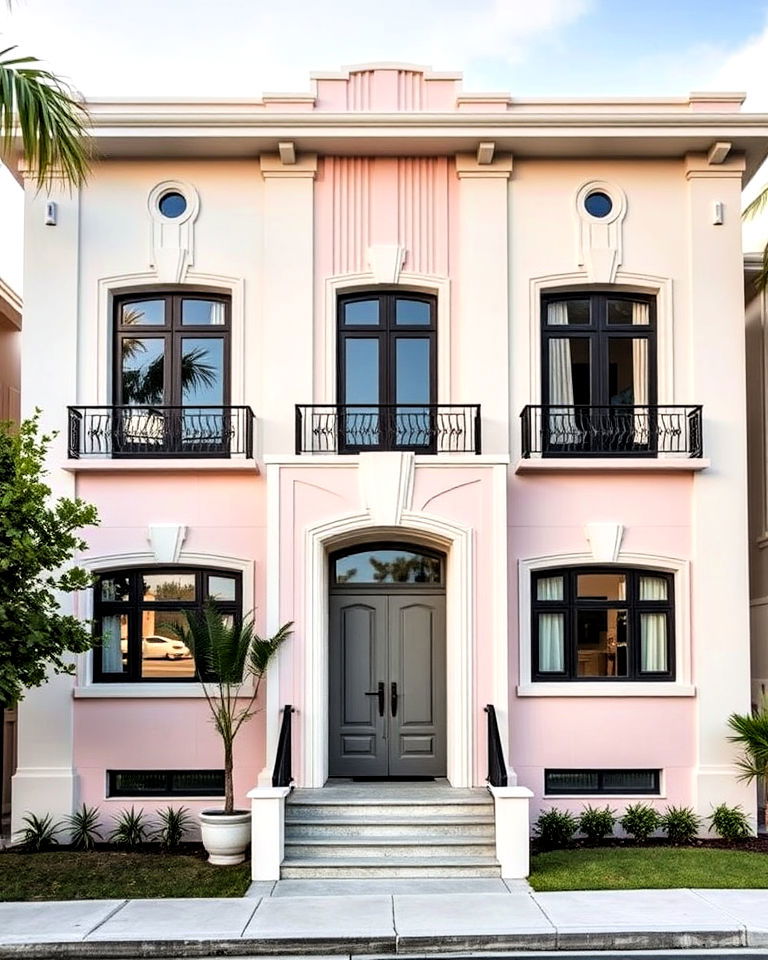
Art Deco facades often utilize soft pastel or muted color schemes, such as pale pinks, creams, or light blues. These tones can be accented with bold blacks, silvers, or golds for contrast. The palette exudes a refined and elegant charm, harmonizing with the sleek architectural details.
14. **Striped or Chevron Patterning**
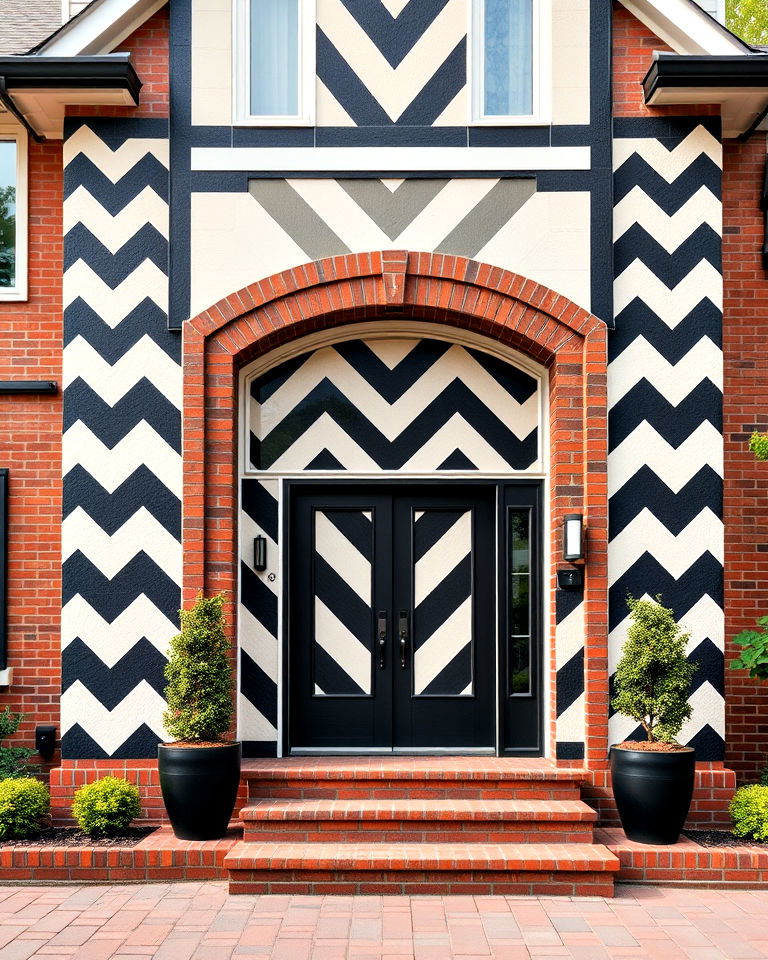
Introduce striped or chevron patterns to the facade through painted panels, brickwork, or relief designs. These geometric motifs add visual energy and align with the decorative nature of Art Deco. Use contrasting colors for a bold effect, or subtle tones for a more understated appearance.
15. **Illuminated Exteriors with Dramatic Lighting**
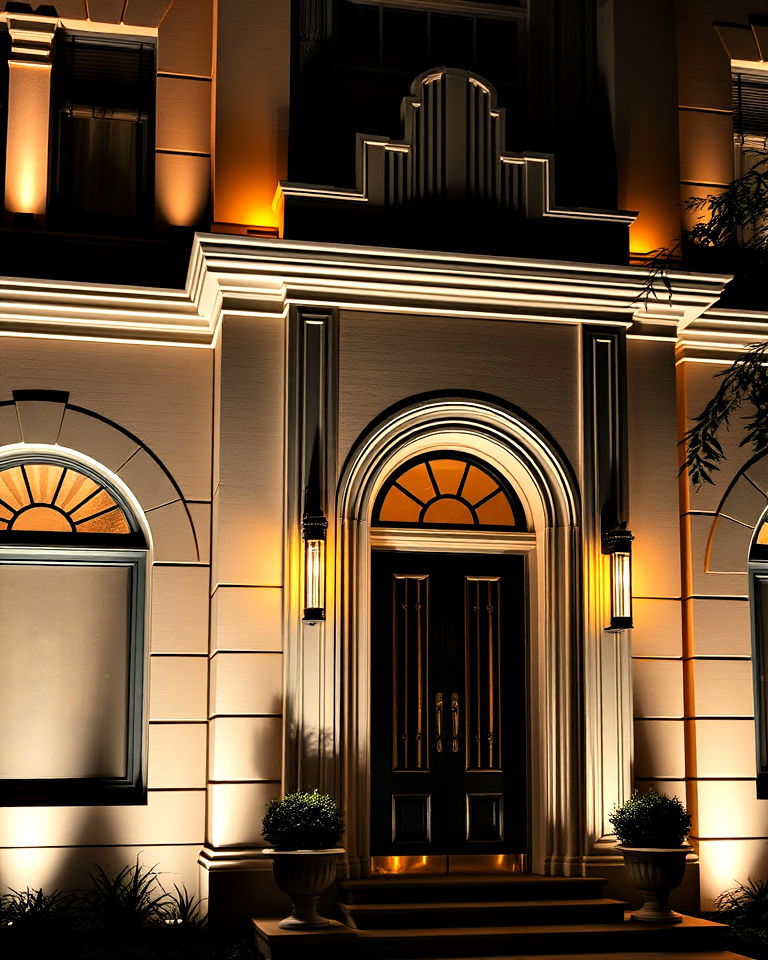
Highlight the architectural details with strategically placed lighting. Use uplights, downlights, or neon to accentuate key features like moldings, parapets, or doorways. The interplay of light and shadow transforms the facade into a dynamic display, especially at night. Lighting is a simple yet impactful way to emphasize the glamour and sophistication of Art Deco design.
Conclusion
Art Deco house exteriors are a testament to the enduring allure of bold design and meticulous craftsmanship. From geometric facades and curved corners to metallic accents and dramatic lighting, each element contributes to a cohesive and striking aesthetic. By incorporating these 15 ideas, you can create a home that not only reflects the elegance of the Art Deco era but also stands as a modern-day masterpiece. Whether you’re drawn to the symmetry of strong axial layouts or the soft hues of pastel palettes, the key lies in balancing boldness with sophistication. Embrace these timeless design principles, and let your home’s exterior tell a story of elegance and innovation.

Leave a Reply